The evolution of SVP. Directions free
In the last article, we looked at the problems in the way of introducing ITS in Russia, which, in general, are common to all high-tech areas based on imported technologies. Today we will talk about the evolution of toll systems on roads.
This class of systems is interesting primarily because it develops as if by itself and independently of the other ITS systems. The customer of almost all ITS systems are government agencies, but only SVPs collect real money. I think it’s not necessary to explain that toll road operators are extremely interested in the marginal efficiency of their systems.
In one of the previous articles, I talked about the architecture of the "classical" SVP, with pictures and diagrams. “Classical” SVP is equipped with barriers and pay booths, it is an impressive building made of metal and concrete, with utility rooms including a control room, a cash counting room, a room and a changing room for staff, etc.
')
No operator wants to keep all this capital economy. Because the basis of the most common relationship between the state and the toll road operator is the principle of “affordability payment”. That is, the state annually pays a specified amount to an operator who performs a certain range of services with a specified quality. In fact, it looks like IT SLA. Thus, the more money the operator spends on the provision of KPI, the less he (and his investors) will remain for bread with caviar.
The operator will keep the toll booths on the road as long as cash remains the main means of payment. As I already wrote, the alternative to paying for travel in cash is electronic contactless cards (like in the subway) or transponders - special devices that provide communication with the SVP equipment using the DSRC wireless protocol based on the IEEE 802.11p standard. The transponder allows you to pass the point of payment without stopping, the fare is charged directly from the user's electronic account.
Transponder GK Avtodor to travel on the highway M-4 "Don"
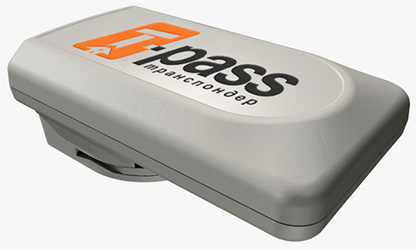
The use of transponders allows you to replace the classic points of payment on a lightweight framework, as is done, for example, in Portugal. Such systems operate in the multi-lane free flow mode and do not impose any restrictions on it.
A typical MLFF system consists of a combination of the following elements:
Typical composition of equipment MLFF
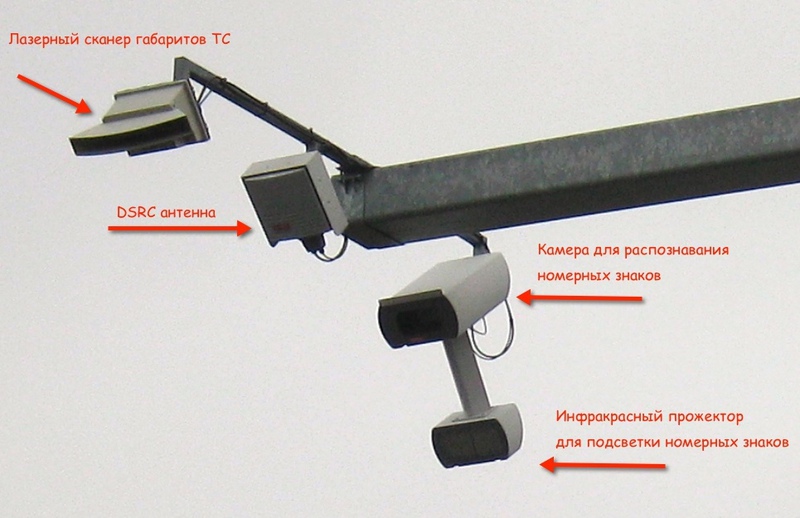
The choice of equipment is determined by the applicable charging rules (tariffs, classes, payment procedure), as well as the requirements for the operator (the percentage of collection fees). All MLFF components are not cheap, industrial performance, and operators use every opportunity to get by with fewer elements.
State requirements are very sophisticated. In the same Portugal, by law, in order to prove the passage under the frame, it is required to provide photos of the front and rear parts of the car, taken simultaneously . Photos taken with an interval of half a second, the Portuguese state is no longer satisfied, so the operators have to build at the point of measuring three frames at a time. An antenna for communication with transponders and laser scanning sensors measuring the vehicle length are placed on the middle, and two cameras are placed on the other two to obtain an image of the vehicle from the front and rear, including the license plate.
Typical MLFF installation in Portugal
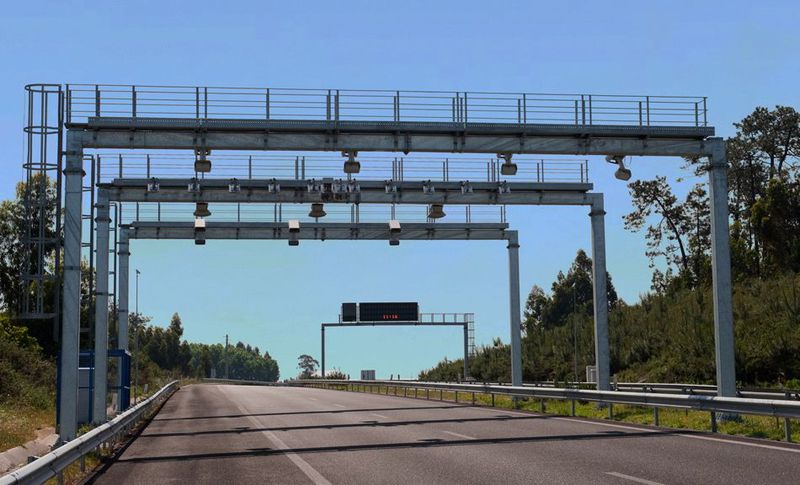
In Sweden, Gothenburg decided to do without transponders at all, obliging motorists to keep their license plates clean and using numbers as their sole identifiers. It is worth noting that at the same time they have rather mild conditions for collecting fees, since they use tolls rather as a measure of transit flow regulation, and not as a means of extracting profit.
MLFF prop in Gothenburg

Regardless of the type of equipment on the support, the algorithm of such a system is extremely simple:
MLFF zone diagram (blue - detection and photography, red - DSRC communication zone, green - classification)
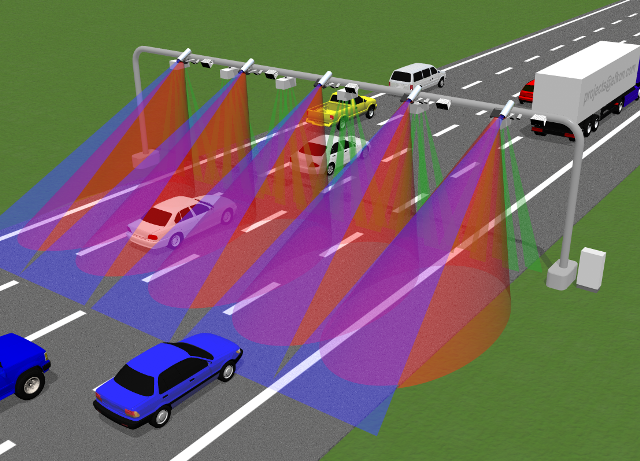
Despite the simplicity of the system, there are many subtleties and nuances. The main one is violators. No need to think that Europe is full of law-abiding lemmings, who are ready to pay without complaint. The share of violators according to statistics is from 5 to 10 percent. Receptions apply different. The easiest is to rebuild at the time of the passage of the frame (option - travel along the side of the road). When there is a transponder, and it stores the vehicle license plate, identification is not a problem, as the cameras look at the overlapping bands. But in a number of countries, the number is not stored in the transponder, and linking the transponder ID with the image of a specific vehicle within a transaction can become a problem. Manufacturers of software for MLFF-class systems compete with each other in the ability to work with "tricky" cases, since they have nothing more to compete with.
Dirty numbers, filled numbers, all sorts of meshes, etc., which makes it difficult to recognize in the infrared range is also a problem. The presence of the transponder helps to soften the requirements for the percentage of recognition, but the transaction log does not fit the case, you need a normally readable image, which may not be.
In the case of using transponders, the main disadvantage is the need for their mass use by road users. The transponder costs a penny, it works for 5-7 years from its own battery, but everyone needs to distribute it or sell it, make drivers attach it to the windshield ...
Broken transponder KAPSCH (photo from here )
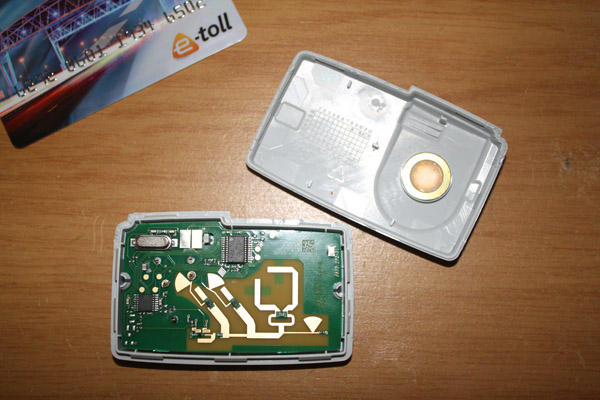
As is customary, in many countries, drivers of commercial vehicles, such as trucks and buses, were hit by transponders. If it is enough for ordinary motorists to get a paper vignette to drive through the autobahns of Austria, truck drivers should travel with transponders.
Also, transponders are actively used by users of “ordinary” toll highways, for which it is both time saving and money saving. In Russia, transponders are offered by all toll road operators, both private and managed by Avtodor.
So, in Europe and the States, MLFF class systems have become an evolutionary continuation of the classic “stop-and-go” systems with barriers and dedicated lanes. But what about Russia, in which there was no “evolution” of SVPs, like the SVPs themselves? Should we speedily go through all the stages of the development of the SVP or, perhaps, take advantage of the unique opportunity to skip some stages of development?
SVPs in the world developed relatively slowly (30 years is a terribly long time for IT), but it was not caused by the laziness of engineers and the conservatism of the customer. The fact is that consumers of SVP are motorists, very few of whom are fans of IT stuff. In order for technology to take root, for the user to realize their benefit for themselves, time is needed. There is little to rely on popular geeks, as in the promotion of mobile electronics. In matters of SVP, we move with the speed of a critical mass of users, we can start talking about the same MLFF when already 60% of people use transponders voluntarily, and you can pledge to 80% voluntary use, putting the remaining 20% of marginals before the fact.
In Russia, the percentage of lovers of new technologies is extremely high, who willingly try various innovations. According to the estimates of specialized agencies of such people, about 30% of all motorists (remember at least the nationwide popularity of DVRs, navigators and other small equipment). If these 30% clearly explain the benefits of new technologies and do not deceive their expectations, we will have a significant number of users at the start, capable of becoming the core of the critical mass, making the introduction of innovations not only “fun”, but also economically beneficial.
At the moment, all of the toll booths operating in Russia are built to support the collection of cash. No one wants to wait for the moment when the percentage of users of electronic means of payment grows by itself to take the next step. Because it means again to lag behind in the wake of western technology with a ten-year lag.
We have a unique opportunity to immediately reach the “technological advanced” SVP, especially since this “advanced technology” for many of our compatriots has been familiar for five years already.
I'm talking about the technology of charging on the basis of satellite monitoring of transport. But more about that in the next article.
This class of systems is interesting primarily because it develops as if by itself and independently of the other ITS systems. The customer of almost all ITS systems are government agencies, but only SVPs collect real money. I think it’s not necessary to explain that toll road operators are extremely interested in the marginal efficiency of their systems.
In one of the previous articles, I talked about the architecture of the "classical" SVP, with pictures and diagrams. “Classical” SVP is equipped with barriers and pay booths, it is an impressive building made of metal and concrete, with utility rooms including a control room, a cash counting room, a room and a changing room for staff, etc.
')
No operator wants to keep all this capital economy. Because the basis of the most common relationship between the state and the toll road operator is the principle of “affordability payment”. That is, the state annually pays a specified amount to an operator who performs a certain range of services with a specified quality. In fact, it looks like IT SLA. Thus, the more money the operator spends on the provision of KPI, the less he (and his investors) will remain for bread with caviar.
The operator will keep the toll booths on the road as long as cash remains the main means of payment. As I already wrote, the alternative to paying for travel in cash is electronic contactless cards (like in the subway) or transponders - special devices that provide communication with the SVP equipment using the DSRC wireless protocol based on the IEEE 802.11p standard. The transponder allows you to pass the point of payment without stopping, the fare is charged directly from the user's electronic account.
Transponder GK Avtodor to travel on the highway M-4 "Don"

SVP free travel
The use of transponders allows you to replace the classic points of payment on a lightweight framework, as is done, for example, in Portugal. Such systems operate in the multi-lane free flow mode and do not impose any restrictions on it.
A typical MLFF system consists of a combination of the following elements:
- Video cameras for obtaining the image of the vehicle and recognition of the license plate;
- DSRC antennas for information exchange with a transponder (in the US, the DSRC function is partially performed by RFID tags);
- Scanning device for determining the size and classification of vehicles.
Typical composition of equipment MLFF

The choice of equipment is determined by the applicable charging rules (tariffs, classes, payment procedure), as well as the requirements for the operator (the percentage of collection fees). All MLFF components are not cheap, industrial performance, and operators use every opportunity to get by with fewer elements.
State requirements are very sophisticated. In the same Portugal, by law, in order to prove the passage under the frame, it is required to provide photos of the front and rear parts of the car, taken simultaneously . Photos taken with an interval of half a second, the Portuguese state is no longer satisfied, so the operators have to build at the point of measuring three frames at a time. An antenna for communication with transponders and laser scanning sensors measuring the vehicle length are placed on the middle, and two cameras are placed on the other two to obtain an image of the vehicle from the front and rear, including the license plate.
Typical MLFF installation in Portugal

In Sweden, Gothenburg decided to do without transponders at all, obliging motorists to keep their license plates clean and using numbers as their sole identifiers. It is worth noting that at the same time they have rather mild conditions for collecting fees, since they use tolls rather as a measure of transit flow regulation, and not as a means of extracting profit.
MLFF prop in Gothenburg

Regardless of the type of equipment on the support, the algorithm of such a system is extremely simple:
- Gathering the most reliable information about a passing vehicle that meets the requirements of local legislation. The information collected is recorded in a so-called travel transaction;
- In the central system, the transaction is checked automatically or manually;
- The tariff is calculated, billing takes place or funds are debited in the case of using a prepaid payment system.
MLFF zone diagram (blue - detection and photography, red - DSRC communication zone, green - classification)

Despite the simplicity of the system, there are many subtleties and nuances. The main one is violators. No need to think that Europe is full of law-abiding lemmings, who are ready to pay without complaint. The share of violators according to statistics is from 5 to 10 percent. Receptions apply different. The easiest is to rebuild at the time of the passage of the frame (option - travel along the side of the road). When there is a transponder, and it stores the vehicle license plate, identification is not a problem, as the cameras look at the overlapping bands. But in a number of countries, the number is not stored in the transponder, and linking the transponder ID with the image of a specific vehicle within a transaction can become a problem. Manufacturers of software for MLFF-class systems compete with each other in the ability to work with "tricky" cases, since they have nothing more to compete with.
Dirty numbers, filled numbers, all sorts of meshes, etc., which makes it difficult to recognize in the infrared range is also a problem. The presence of the transponder helps to soften the requirements for the percentage of recognition, but the transaction log does not fit the case, you need a normally readable image, which may not be.
In the case of using transponders, the main disadvantage is the need for their mass use by road users. The transponder costs a penny, it works for 5-7 years from its own battery, but everyone needs to distribute it or sell it, make drivers attach it to the windshield ...
Broken transponder KAPSCH (photo from here )

As is customary, in many countries, drivers of commercial vehicles, such as trucks and buses, were hit by transponders. If it is enough for ordinary motorists to get a paper vignette to drive through the autobahns of Austria, truck drivers should travel with transponders.
Also, transponders are actively used by users of “ordinary” toll highways, for which it is both time saving and money saving. In Russia, transponders are offered by all toll road operators, both private and managed by Avtodor.
So, in Europe and the States, MLFF class systems have become an evolutionary continuation of the classic “stop-and-go” systems with barriers and dedicated lanes. But what about Russia, in which there was no “evolution” of SVPs, like the SVPs themselves? Should we speedily go through all the stages of the development of the SVP or, perhaps, take advantage of the unique opportunity to skip some stages of development?
State of the art
SVPs in the world developed relatively slowly (30 years is a terribly long time for IT), but it was not caused by the laziness of engineers and the conservatism of the customer. The fact is that consumers of SVP are motorists, very few of whom are fans of IT stuff. In order for technology to take root, for the user to realize their benefit for themselves, time is needed. There is little to rely on popular geeks, as in the promotion of mobile electronics. In matters of SVP, we move with the speed of a critical mass of users, we can start talking about the same MLFF when already 60% of people use transponders voluntarily, and you can pledge to 80% voluntary use, putting the remaining 20% of marginals before the fact.
In Russia, the percentage of lovers of new technologies is extremely high, who willingly try various innovations. According to the estimates of specialized agencies of such people, about 30% of all motorists (remember at least the nationwide popularity of DVRs, navigators and other small equipment). If these 30% clearly explain the benefits of new technologies and do not deceive their expectations, we will have a significant number of users at the start, capable of becoming the core of the critical mass, making the introduction of innovations not only “fun”, but also economically beneficial.
At the moment, all of the toll booths operating in Russia are built to support the collection of cash. No one wants to wait for the moment when the percentage of users of electronic means of payment grows by itself to take the next step. Because it means again to lag behind in the wake of western technology with a ten-year lag.
We have a unique opportunity to immediately reach the “technological advanced” SVP, especially since this “advanced technology” for many of our compatriots has been familiar for five years already.
I'm talking about the technology of charging on the basis of satellite monitoring of transport. But more about that in the next article.
Source: https://habr.com/ru/post/179119/
All Articles